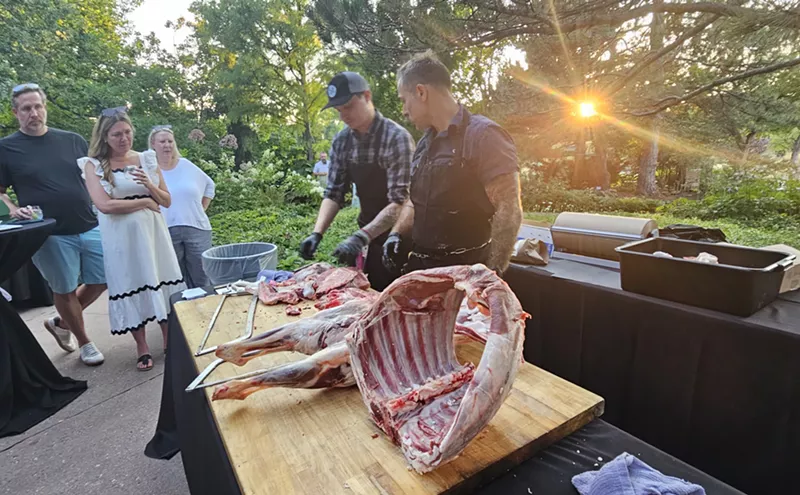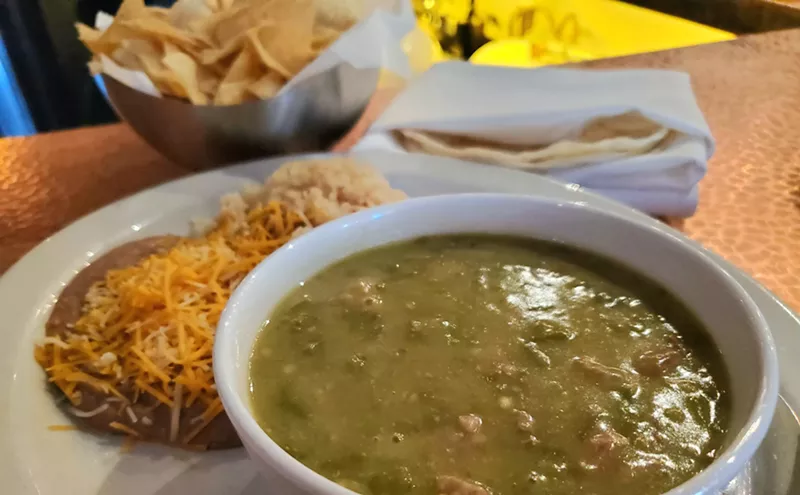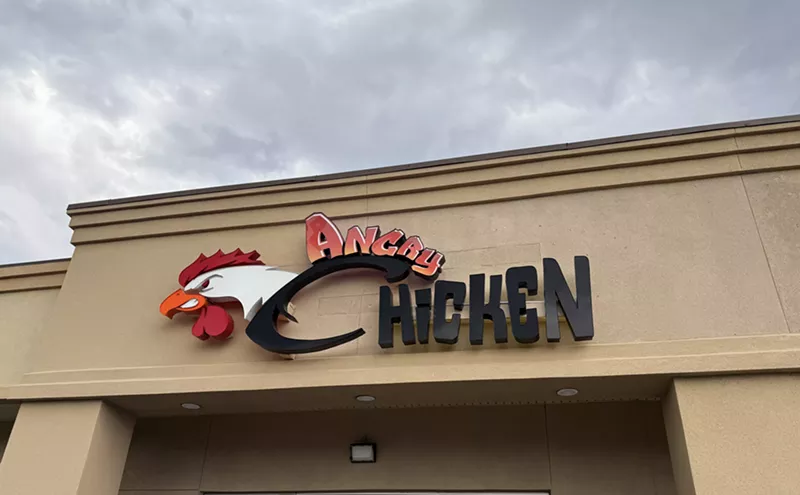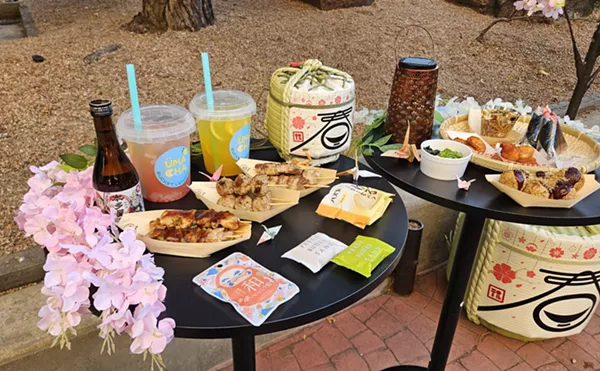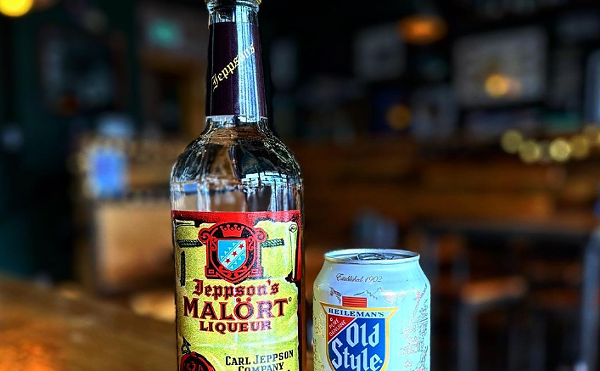What tables we could see were set with wineglasses, white cloths and crimson napkins stiffly folded into the shape of three-point crowns, but there was no one doing any last-minute fussing. The bar in front was empty.
"The sign says they open at five," Laura said. "What time is it now?"
I checked my watch. "Ten till. But you'd think there'd be someone moving around in there. Getting ready."
We moved closer, up to what had been a glassed-in porch when this house was just a house. Now a waiting area, the space held a couple of chairs and a wall pasted with yellowing press clippings that showed tiny men clinging like spiders to walls of ice, mountains draped with scarves of fog and the owner of the place -- Pemba Sherpa -- smiling, over and over. But there was still no sign of the flesh-and-blood Sherpa, or any other living human.
We walked back to the car and sat with the engine idling. "If they were really closed, you'd think they'd have a sign or something, wouldn't they?" Laura asked. On the sidewalk, an older man was walking our way. Silver hair, a neatly trimmed white beard, loose vest over a collarless, button-down shirt with a silver medallion on a leather thong hanging around his neck. He looked like a hippie Gandalf after a Queer Eye makeover slowly approaching the Prancing Pony tavern in Bree.
"Let's see what Gandalf does," I said, and we watched him stop in front of Sherpa's, cock his head, look over the menu posted outside, then try the door. Still locked. He toddled away.
"Look," Laura said. "We're already here. Let's give them ten minutes and see what happens."
So we drove around Boulder for fifteen minutes, then returned to Walnut Street -- where Sherpa's was now alive with light. It poured out of the windows, warm like melted butter, splashing onto the cold, empty patio. Along the white picket fence fronting the sidewalk, small lamps burned like fireflies on sticks, and cars had already begun to stack up on the street.
"Well," I said. "Guess it's a good thing we waited."
Inside, the dining rooms were filling up, and while the bar was still empty of people, it was full of books on Tibet and Nepal, on mountaineering and trekking; full of souvenirs like prayer wheels and photographs, tattered canvas gunny bags and crossed snowshoes dark and ratty with long use. Pemba Sherpa -- a native of Nepal who grew up in the shadow of Sagarmatha, of Everest, and made his living as a mountain guide before settling in Colorado -- built the restaurant around his idea for this bar, his "traveler's lounge." It was to be a place for climbers and adventurers to gather and plan, to reminisce, to tell true stories and make up a few others over cold beers and warm butter tea. He wanted it to be "the place to relive the glories of past adventures and plan new ones," which was a beautiful thought. And that sentiment seemed etched into the set of every table and every plank in the bar. It had the adventures, just not the adventurers.
I touched the spines of the thick books on the shelf, looking at posters for Sherpa Ascent International advertising treks to Nepal and Africa and South America that all ended with "For information, contact Pemba Sherpa at Sherpa's Adventurers Restaurant." That line gave me visions straight out of my adolescent obsession with high-fantasy lit, dredging up ghosts of men in hooded cloaks occupying torch-lit taverns. I didn't find Tolkein's hobbits and their fuzzy ilk until the early '80s, when they'd fallen somewhat out of vogue. But as any great book will, ol' J.R.R.'s trilogy made me want to go out questing for all those lost places he'd seen in his best dreams. And in truth, I never stopped looking for them.
The bar at Sherpa's rang a lot of those old bells. Absent customers, absent guttering torches and tables spread with secret maps, it still seemed nearly perfect -- like a stage set, only waiting for players to come and tread the boards. The dining rooms -- once the parlors, living and sitting rooms of this old house -- were bright and warm and immaculately well kept, like Grandma's house if Grandma were a world traveler, if she collected ice axes and ascent permits instead of ceramic kitties and World's Best Grandma coffee mugs, if her cupboards were full of cumin, papadum and chickpea flour instead of Hydrox cookies and mint tea.
Laura and I were seated in one of the side rooms, at a table with windows on three sides. The view wasn't much -- we looked out over the empty patio at dry streamers of climbing vine and a cast-off piece of kitchen machinery -- but we could also see the slow, steady parade of customers coming from either direction, converging on Sherpa's front door.
Our waiter, a Sherpa like all the staff, arrived while we were still poring over the menu, bringing me a thin, yogurt-sour cinnamon lashi laced with rosewater. He nodded every time we added something to our order. We wanted Sherpa rolls -- house-made panir cheese, glass noodles and shredded vegetables rolled up and lightly fried in a chickpea-flour skin like a meatless eggroll with a touch of deep sweetness -- and panir pokara. At some point in its development, every culture must come up with a native dish involving fried cheese, and for India, Nepal and Tibet, panir pokara is it. We added vegetable samosa to the list, and our waiter nodded again. Oh, and momo. Couldn't forget the momo.
Momo are strange things. They're dumplings, almost always steamed, chewy and usually stuffed with a ragout of shredded vegetables or stringy spiced meat. They're always served with a spicy tomato-pepper chutney, generally with a cooling yogurt raita either spooned over the top or on the side, and they exist almost as a spiritual place-holder on the dumpling spectrum. They're a liminal food eaten in a liminal place -- both the dumplings and the people who eat them at a crossroads of many cultures and many cuisines. In appearance, momo borrow heavily from the Chinese dumpling tradition to the east on the spectrum, but taste as much like Chinese dumplings as a marshmallow tastes like a scallop. They also resemble the Russian version, called pelmeni, which always come slathered in sour cream and often with a side of cold, pickled beets. Traveling much further west on the scale is to venture into the land of pierogis and gnocchi, but momo exist somewhere between, with a mongrel taste that's Middle Eastern, Chinese, Russian, Afghan, Indian and more, all at once. Like fried cheese, the dumpling exists in one form or another in all the world's culinary canons. And momo -- tougher than Chinese dumplings, more savory than pelmeni, more substantial than pierogis, and less limp and bland than the dumplings of the American South -- are the high-mountain link in the dumpling line that connects East to Far East and Far East back to West again.
Between courses -- after the appetizers, after a shared plate of momo, but before the real entrees began arriving -- Laura and I ate papadum with tamarind sauce and spicy tomato chutney, drank dall soup that was a bit too murky and bland, and tried desperately not to laugh. Tolkein had made yet another appearance at dinner -- this time in the form of a vapid discussion of the homoerotic subtext of The Lord of the Rings movies between two people at a table just ahead of ours. It was a one-sided conversation, dominated by a woman who was dull as only a deconstructionist can be, intensely interesting only to the man she sat with, who was listening as only a man who wants to lay a deconstructionist can. Still, it had its moments. Like when the woman praised Hollywood for its bravery in making a movie whose primary love story was between two short men with such hairy feet.
She didn't laugh when she said that.
Neither did her smitten beau.
The next round of plates brought saag, spicier in its Nepalese translation than the Indian version I'm most accustomed to, but still good. The sharp bite of cumin was blunted by the strong, green earthiness of the spinach, offset by garlic's round smoothness, and the dish carried an odd hint of ginger and lemon's citric snap. Tasting it was like having pizza for the first time in Rome, where what they serve in the trattorias is undoubtedly pizza, and pretty good, but unlike any pizza you've ever tasted before in your life.
Most of Sherpa's offerings gave me that same feeling. The naan, the Indian korma (creamy and gentle, with huge chunks of chicken, boiled cashews and just a bare edge of curry), the dall and masala all tasted familiar, but somehow different. Spices were rearranged, and the flavor spikes came in odd places. The korma was made without raisins, its sauce cream-thinned and sweet rather than deep and earthy.
The most foreign-sounding thing on the menu wound up being the most familiar. Sherpa stew was just a lamb stew -- but a wonderful lamb stew, the huge bowl brimming with soft carrots, cauliflower, peppers and potatoes, more dumplings and fat chunks of tender lamb, all swimming in a spicy broth. Still, at my first spoonful, I felt somehow cheated: I'd just discovered I could travel halfway around the planet, climb into the clouds along the spine of the world's highest mountain range, go to a place where they speak twenty languages, not one of them English, order a bowl of stew and get something that my grandma (she of the World's Best Grandma coffee mugs) probably made once a week for most of her life.
But then, as with fried cheese and dumplings, every culture and every cuisine has a common recipe for stew. Because all of the people living in all those countries all over the world had grandmothers who probably made something similar, once a week, for most of their lives. Something slow-simmered and hearty, kicked up with local spices, rich with vegetables and scraps and whatever meat might be lying around, cooked down for hours till all the flavors mingled and all the parts grew soft and infused with spice. Sherpa stew has probably spent generations doing for Everest mountain guides what menudo does for Mexican churchgoers and Dinty Moore does for American families: It brings 'em to the table, sobers 'em up if they're drunk, fills 'em up when they're hungry, and does it all with no fuss.
When we were done with our dinner, sitting back and admiring the twinkling of lights against the dark street, I realized the one disappointing irony of an otherwise delightful place. It wasn't that the food was less adventurous than I expected from a restaurant with "adventure" in its name; in fact, I liked it better for its gentle, comforting simplicity.
It wasn't that the "traveler's lounge" likely catered to more hobbit-lovers and armchair adventurers than actual travelers. That's the way with a lot of places, I think. The people they're built for are rarely the ones who show up night after night, the ones looking to feel like the people for whom a place was built. How often do you see John Elway hanging out around a downtown sports bar? And how often do you see some beer-drunk yahoo at that same bar wearing Elway's jersey?
And it wasn't even that the waiters and cooks serving these people were the ones who'd really been somewhere -- who'd come down from the roof of the world to walk among the lowlanders and make them momo and tea.
No, the irony was that in this place where memories brought back from 20,000 feet decorated the walls and books about the high country filled all the shelves, the one thing you couldn't see from Sherpa's windows was the spine of mountains in whose shadow Sherpa's sat.



